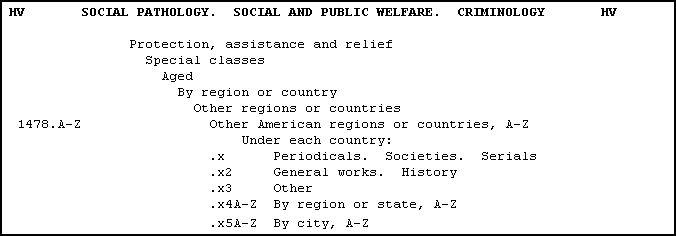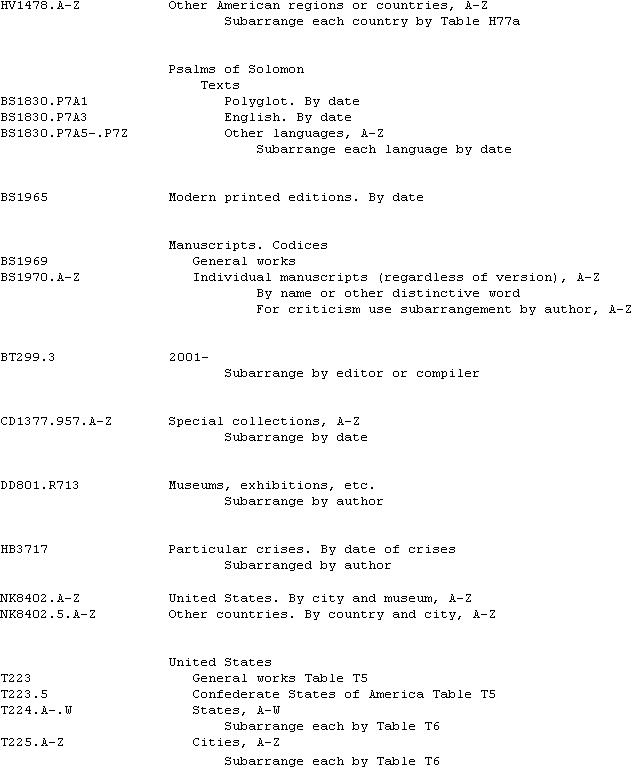Cataloger's Reference Shelf
Subject Cataloging Manual: Shelflisting
G 58 Interpreting the Classification Schedules (was part of G 60) (General)
BACKGROUND: The shelflisting technician consults the classification schedules to ensure that the proper classification has been provided for the work in hand and to determine whether any special instructions for completing the call number are presented. Normally the first one or two subject headings on the bibliographic record reflect the same subject matter shown in the schedule. The words used in the subject heading and the words in the classification caption need not be identical. For example, the subject heading(s) may read Physical fitness for children and/or Physical education and training, whereas the caption for the class number that the cataloger has provided (GV481) appears in the schedule as Calisthenics. Group exercises.
The names of specific individuals, corporate bodies, or places that may appear in subject headings usually do not appear in the classification schedules. The schedule may simply provide a general caption, e.g., Biography -- Individual, A-Z.
In addition to the classification number and the topic, the schedule may include instructions for the subarrangement of the class according to special tables or lists of Cutter numbers. These instructions always take precedence over the shelflisting procedures and tables normally used, such as the Regions and Countries Table (see G 300) or the Biography Table (see G 320). These instructions may appear on the caption line, several lines above the caption, or indeed dozens of pages before the class number selected. Be certain to follow explicit instructions that may be found under a general caption at a higher level than the specific topic given.
The examples on the following pages illustrate some of the common types of instructions found in the LC classification schedules, with information on how the call number will be completed.
Illustration #1. No special instruction: Single Cutter for main entry

No specific subarrangement instructions for these numbers are provided in the schedule. A single Cutter number based on the first word of the main entry is assigned to works classed in numbers like these.
Illustration #2. Reserved Cutters

This example presents three different Cuttering situations. The Cutters .A1-49 are reserved for special types of publications. General works use the range .A5-Z.
Periodicals are Cuttered for main entry, resulting in two Cutters appearing in the call number, which is called "double Cuttering."
In the span .A2-A4, the main entry must fit in this limited span of .A2 to .A4999... The actual Cutter number selected depends on works already shelflisted in that number: the alphabetical position is determined and the number selected to make the entry file correctly and provide for space for future expansion.
A general work is Cuttered for main entry, but when the main entry begins with A, the Cutter number must be adjusted to fit the limited range available. For example, the author Abbott could not receive the normal Cutter .A22. The Cutter number must begin with .A5, so .A52 could be chosen. If the first work in this class is by Andrews, the Cutter number .A53 should not be chosen; .A63 would be preferable in order to leave space for authors with names beginning Ab- Am.
Illustration #3. Double Cutter -- second Cutter for main entry

This example is similar to DS127.A1 above. In both cases, a first Cutter number represents the form of material or the subject of the book. It is printed in the schedule. A second Cutter number is assigned for the main entry.
Illustration #4. Double Cutter -- second Cutter for main entry

This example is similar to the previous one. For a general work, the first Cutter (.A3) has already been specified in the schedule as a breakdown of the class number. A second Cutter is assigned for the main entry.
The .A5-Z will also result in two Cutter numbers, the first for the geographic area and the second for the main entry. For countries beginning with the letter A, the Cutters need to be adjusted to accommodate the smaller span allowed.
Illustration #5. Double Cutter -- second Cutter for main entry

This number is not considered to be a "biography number" (See F 275 and G 320). Biographies classed in this number are, however, double Cuttered. The first Cutter represents the biographee, as indicated by the first subject heading. Because this is not a "biography number", no table is used. The second Cutter represents the main entry. This results in the presence of some single-Cuttered works in this class number, representing works simply about that historical period, and some double-Cuttered works, representing biographies.
Illustration #6. Double Cutter -- digit added for main entry

Because the second Cutter is derived from the name of the railroad to represent the subject, it is necessary to extend the digits of the second Cutter to represent the main entry. The numbers selected depends on the items already shelflisted. If a railroad is used for the first time, the last digit should approximate the position of the main entry in the alphabet. For example, if TF859.Z5P46 represents electrification of the Pennsylvania Railroad, then the author Carleton could be represented by a 3, resulting in TF859.Z5P463.
Illustration #7. Double Cutter -- digit added for main entry

It is necessary to consult the table, which reads
![]()
However, if the work is limited to a specific place, the digit 2 is added to the topical Cutter and the second Cutter is used for the place. The main entry can therefore be represented only by a digit. For example, language planning in Ireland classes in P40.5.L352I75, with L352 reflecting the alphabetical listing of countries and I75 representing Ireland. A work by O'Laorie would use the digit 6, resulting in P40.5.L353I756.
Illustration #8. Double Cutter -- digit added for main entry

An individual work about the Vanguard program would use digits to show the alphabetical order of main entries. For example, a work by Green is Cuttered .U6V35, and a work by Stehling is Cuttered .U6V37.
Illustration #9. "Under each" subarrangements: .x and .x2

The notation ".x" refers to the Cutter number selected for the item being shelflisted. .x2 means that the digit 2 is appended to that Cutter number. For example, the Cutter number for Venezuela in G 300, in the absence of conflict in the shelflist, is .V4. A general work on older people in Venezuela would be HV1478.V42. A Cutter number for the main entry would then be added. For a work on the elderly in Caracas, the call number would begin with HV1478.V45C37, and the author would be reflected in the digit after the 7.
Illustration #10. Examples of a variety of captions with special instructions for shelflisting
It is particularly important that the schedule be consulted before shelflisting because special instructions, such as those below, may affect the creation of the book number.

To return: